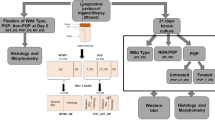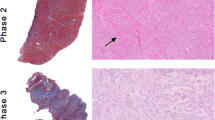Abstract
Using a specific myofibroblast contraction test, we try to predict future utero-vaginal prolapse development in young primiparae women. We compare myofibroblast cultures of the vaginal wall in primiparae women (group 1), young multiparae women (group 2) and older multiparae women (group 3) who were operated on for severe utero-vaginal prolapse. A myofibroblast-mediated collagen gel contraction assay determined a contraction factor that was compared in the three groups of women. The myofibroblasts contraction factor after 24 and 48 hours was significantly higher in group 1 women (2.4 ± 0.6/4.4 ± 1.9) compared to group 2 (1.6 ± 0.3/ 1.8 ± 0.1) andgroup 3 (1.6 ± 0.3/1.8 ± 0.3), but showed no differences in group 1 women without (2.1 ± 0.5/3.5 ± 1.9) and with (2.7 ± 0.6/5.1 ± 1.7) cystocoele. Vaginal myofibroblasts of young women show better contraction forces than young women with severe utero-vaginal prolapse. The latter have a myofibroblast contraction factor similar to those of older post-menopausal women operated for the same condition.



Similar content being viewed by others
References
Swift SE (2000) The distribution of pelvic organ support in a population of female subjects seen for routine gynecologic health care. Am J Obstet Gynecol 183:277–85
Samuelsson EC, Arne Victor FT, Tibblin G, Svardsudd KF (1999) Signs of genital prolapse in a Swedish population of women 20 to 59 years of age and possible related factors. Am J Obstet Gynecol 180:299–305
Fry CH, Brading AF, Hussain M, Lewis SA, Takeda M (2005) Cell biology. In: Abrams P, Cardozo L, Khoury S, Wein A (eds) Incontinence, volume 1, Basics & evaluation. Health Publication, Paris, pp 313–362
Poncet S, Meyer S, Richard C, Aubert JD, Juillerat-Jeanneret L (2005) The expression and function of the endothelin system in contractile properties of vaginal myofibroblasts of women with uterovaginal prolapse. Am J Obstet Gynecol 192:426–432
Swift S (2002) Current opinion on the classification and definition of genital tract prolapse. Curr Opin Obstet Gynecol 14(5):503–507
Lee YR, Oshita Y, Tsuboi R, Ogawa H (1996) Combination of insulin-like growth factor (IGF)-1 and IGF-binding protein promotes fibroblast-embedded collagen gel contraction. Endocrinology 137:5278–5283
O’Boyle AL, Woodman PJ, O’Boyle JD, Davis GD, Swift SE (2002) Pelvic organ support in nulliparous pregnant and nonpregnant women: a case control study. Am J Obstet Gynecol 187:99–102
Mant J, Painter R, Vessey M (1997) Epidemiology of genital prolapse: observations from the oxford family planning association study. Brit J Obstet Gynecol 104:579–585
Moalli PA, Klingensmith WL, Meyn LA, Zyczynski HM (2002) Regulation of matrix metalloproteinase expression by estrogen in fibroblasts that are derived from the pelvic floor. Am J Obstet Gynecol 187:72–79
Arnold EP, Burgio K, Diokno AC, Herzog AR, Mallet VT (1998) Epidemiology and natural history of urinary incontinence. In: Abrams P, Khoury S, Wein A (eds) Incontinence: 1st international consultation on incontinence. Plymbridge Distributors, Plymouth, pp 165–202
Chiaffarino F, Chatenoud L, Dindelli M, Meschia M, Buonaguidi A et al (1999) Reproductive factors, family history, occupation and risk of urogenital prolapse. Eur J Obstet Gynecol & Reprod Biol 82:63–67
Meyer S, Schreyer A, De Grandi P, Hohlfeld P (1998) The effects of birth on urinary continence mechanisms and other pelvic floor characteristics. Obstet Gynecol 92:613–618
Wong MY, Harmanli OH, Agar M, Dandolu V, Grody MH (2003) Collagen content of nonsupport tissue in pelvic organ prolapse and stress urinary incontinence. Am J Obstet Gynecol 189:1597–1599
Goepel C, Hefler L, Methfessel HD, Koelbl H (2003) Periurethral connective tissue status of postmenopausal women with genital prolapse with and without stress incontinence. Acta Obstet Gynecol Scand 82:659–664
Chen BH, Wen Y, Li H, Polan ML (2002) Collagen metabolism and turnover in women with stress urinary incontinence and pelvic prolapse. Int Urogynecol J 13:80–87
Visco AG, Yuan L (2003) Differential gene expression in pubococcygeus muscle from patients with pelvic organ prolapse. Am J Obstet Gynecol 189:102–112
Chen BH, Wen Y, Zhang Z, Wang H, Warrington JA et al (2003) Menstrual phase-dependent gene expression differences in periurethral vaginal tissue from women with stress incontinence. Am J Obstet Gynecol 189:89–97
Hinz BG, Gabbiani G (2003) Mechanisms of force generation and transmission by myofibroblasts. Curr Opin Biotechnol 14:538–546
Tomasek JJ, Gabbiani G, Hinz B, Chaponnier C, Brown RA (2002) Myofibroblasts and mechanoregulation of connective tissue remodeling. Nature Rev Mol Cell Biol 3:349–363
Dugina V, Alexandrova A, Chaponnier C, Gabbiani G (1998) Rat fibroblasts cultured from various organs exhibit differences in alpha-smooth muscle actin expression, cytoskeletal pattern, and adhesive structure organization. Exp Cell Res 238:481–490
Serini G, Gabbiani G (1999) Mechanisms of myofibroblast activity and phenotypic modulation. Exp Cell Res 250:273–283
Conflicts of interest
None.
Author information
Authors and Affiliations
Corresponding author
Rights and permissions
About this article
Cite this article
Meyer, S., Achtari, C., Hohlfeld, P. et al. The contractile properties of vaginal myofibroblasts: Is the myofibroblasts contraction force test a valuable indication of future prolapse development?. Int Urogynecol J 19, 1399–1403 (2008). https://doi.org/10.1007/s00192-008-0643-6
Received:
Accepted:
Published:
Issue Date:
DOI: https://doi.org/10.1007/s00192-008-0643-6




